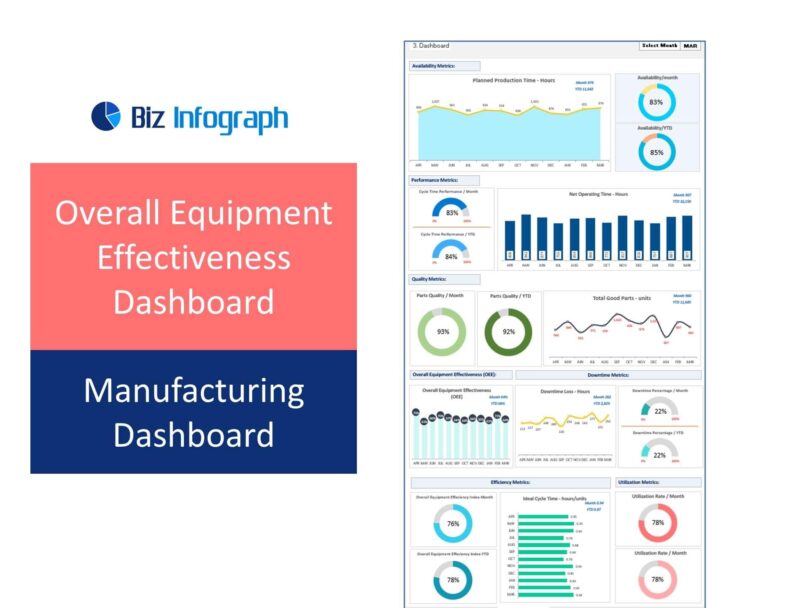Introduction to Overall Equipment Effectiveness (OEE)
Manufacturing operations in the modern world require absolute efficiency as their main priority. Manufacturers need Overall Equipment Effectiveness Dashboard to run at optimum capacity because this leads to market success. The assessment of equipment effectiveness through Overall Equipment Effectiveness (OEE) has established itself as a fundamental method for measuring equipment operational efficiency. The three fundamental elements of OEE combine to deliver a complete understanding of production performance through Availability and Performance and Quality metrics. The performance of a machine depends on all these dimensions for proper operation.
The main reason OEE exists is to help manufacturers detect production losses while tracking performance improvements and maximizing equipment operational efficiency. The OEE score decreases when equipment malfunctions and operating speeds fall short of optimal levels and defective products are produced. The journey of OEE improvement results in lower operational costs and higher production output and improved customer satisfaction.
However, tracking OEE manually or through disparate systems is a major challenge for many operations. The process of data collection from various production line sources results in delayed and inaccurate or missing reports. This is where the power of an comes into play. The dashboards show real-time factory floor performance data through centralized information systems which enable users to get useful insights about factory floor operations.
The Role of an OEE Dashboard in Modern Manufacturing
An OEE dashboard operates as an interactive system which transforms operational data into understandable information for users. Manufacturers should use dashboards to consolidate their metrics instead of depending on spreadsheets and separate reports. A centralized system provides improved communication channels which leads to faster decision-making and flexible manufacturing operations.
Dashboards help organizations understand the large amounts of data which equipment sensors and production systems produce. The system updates its data by integrating with manufacturing execution systems through machine operations. The dashboard uses this data to show performance deficiencies while monitoring patterns and recommending areas for enhancement.
Real-time monitoring is one of the most powerful features of an OEE dashboard. The system includes built-in capabilities which detect system performance decline and system failures and service quality problems. Plant managers and supervisors now can act before problems occur instead of simply dealing with what has already happened. The change from reactive to proactive management enables organizations to achieve quicker recovery times while minimizing production disruptions.
Key Metrics Displayed in an OEE Dashboard
An OEE dashboard needs precise and useful data to operate at its best. The fundamental elements of an OEE dashboard consist of Availability and Performance and Quality metrics which form the core of the OEE formula. Availability reflects the percentage of scheduled time that the equipment is actually operating. The model includes unplanned system stoppages and maintenance activities and equipment changeovers. The tracking of equipment availability enables operators to determine how frequently their equipment operates according to plan versus remaining inactive.
The operational speed of equipment is measured through performance to check if it runs at its best possible level. A machine that operates correctly can still experience reduced performance because of brief interruptions and operational inefficiencies and human-caused delays. Performance monitoring allows organizations to detect performance issues which enables them to make specific enhancements.
Quality represents the proportion of high-quality products that exist in relation to the complete production output. Scrap, rework, or defects reduce the quality score. The metric ensures that output speed and consistency do not affect the required standards.
A well-designed OEE dashboard shows these three areas through visual elements which include charts and status indicators. The report needs to include additional details which explain system failures and their frequency patterns and it should also present operational performance data for each shift and operator. Organizations can determine their most important availability disruptions by studying the recurring factors that lead to system downtime. The collected data will serve to establish future preventive maintenance schedules and operator training programs.
Building an Effective OEE Dashboard
The first step to build an OEE dashboard requires selecting an appropriate platform. The choice between a centralized and decentralized data warehouse depends on multiple organizational elements which include company dimensions and available data resources and current system infrastructure. Small manufacturers together with pilot programs can create essential Excel dashboards through customization options for fundamental development. These systems enable teams to start monitoring OEE operations at a minimal financial cost. The systems need manual maintenance, but they do not provide immediate access to current information.
Business intelligence tools Power BI and Tableau offer specialized capabilities which serve organizations that need advanced features for their extensive operations and automated systems. These platforms enable dashboards to establish direct connections with data sources that include machine sensors and ERP systems and manufacturing execution systems. The real-time data updates in dashboards display instant operational changes which give users a current understanding of plant operations.
A user-centered design method should guide the development of dashboard interfaces which need to operate efficiently. A dashboard that presents excessive information in an unorganized manner will confuse users which results in lower user engagement. The design needs to stay basic but should include visual elements which display performance metrics by using colors and symbols. The system shows green for on-target metrics but displays yellow for caution and red for underperformance. The visual elements of trend lines and gauges and bar charts allow users to quickly comprehend data information.
Customization is also important. The dashboard requires data that matches specific operational requirements of each manufacturing site because every facility operates with distinct operational needs and priorities. A proper design process requires team collaboration to achieve both functional requirements and system integration with existing operational systems. The development process receives their input which results in higher system adoption rates and extended system usage.
The main function of OEE dashboards is to help organizations reach their operational excellence targets through continuous improvement.
Once the dashboard is in place, its real value comes from how it’s used. The system needs to operate as an ordinary tool for conducting production meetings and shift handovers and performance reviews. The dashboard requires managers and operators to perform regular checks for progress evaluation and challenge discussion and action plan development.
Conclusion
Manufacturing operational excellence requires data to function as its fundamental achievement foundation. The data needs further processing to become useful information. It must be organized, visualized, and acted upon. The Overall Equipment Effectiveness dashboard provides its most important advantages during this stage. The platform integrates vital performance metrics into a single user-friendly system which helps teams monitor and boost their production efficiency.
The three pillars of OEE—Availability, Performance, and Quality—establish a structured system for evaluating equipment productivity. The insights become inaccessible when they exist only in spreadsheets or separate systems without a dashboard. The dashboard system provides manufacturers with the ability to perform immediate actions and execute modifications and improvements. Bizinfograph offers ready-to-use dashboard templates on Finance, Sales, HR and Manufacturing.







